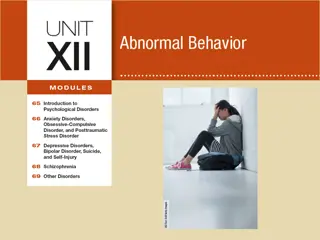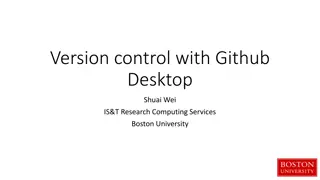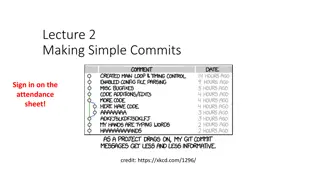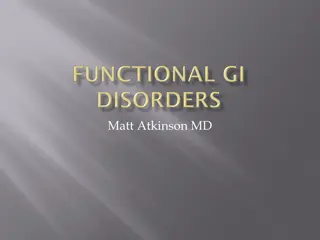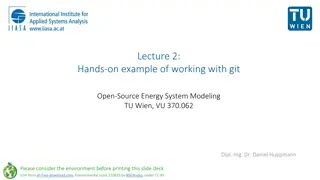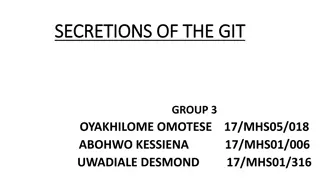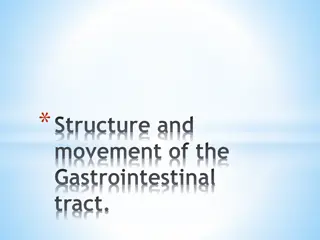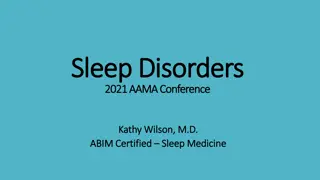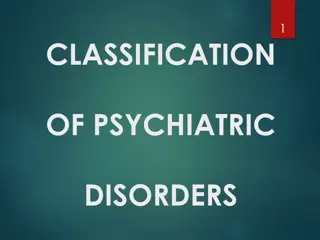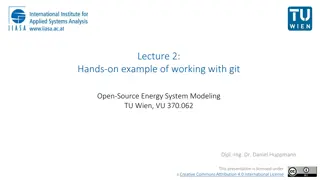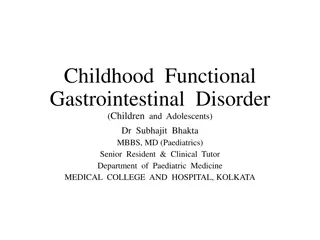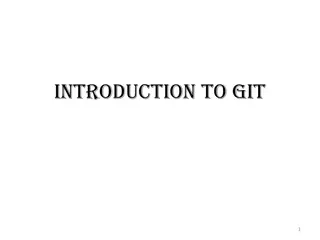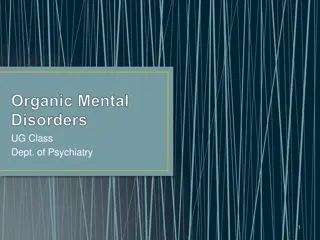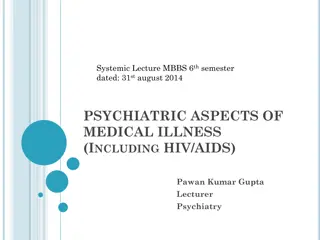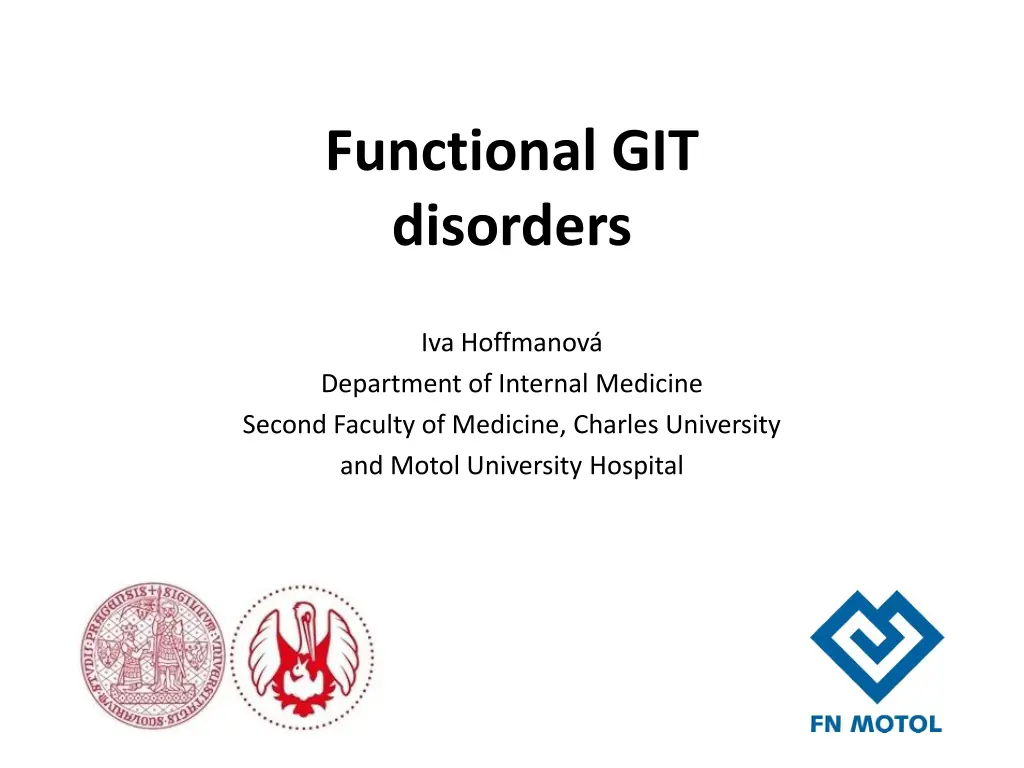
Understanding Functional GIT Disorders and Symptomatology
Explore the common functional GIT disorders affecting 5-20% of the worldwide population, characterized by symptomatology without specific diseases. Learn about the pathophysiology, anamnesis of GIT diseases, different types of abdominal pain, and history of abdominal pain onset. Gain insights into visceral and somatic pain, along with the intensity of pain during time.
Download Presentation

Please find below an Image/Link to download the presentation.
The content on the website is provided AS IS for your information and personal use only. It may not be sold, licensed, or shared on other websites without obtaining consent from the author. If you encounter any issues during the download, it is possible that the publisher has removed the file from their server.
You are allowed to download the files provided on this website for personal or commercial use, subject to the condition that they are used lawfully. All files are the property of their respective owners.
The content on the website is provided AS IS for your information and personal use only. It may not be sold, licensed, or shared on other websites without obtaining consent from the author.
E N D
Presentation Transcript
Functional GIT disorders Iva Hoffmanov Department of Internal Medicine Second Faculty of Medicine, Charles University and Motol University Hospital
Functional GIT disorders common disorders 5 to 20 percent worldwide symptomatology without disease ~ diagnosis of exclusion anamnesis (no alarming signs) such as: bleeding into GIT, icterus, pus in feces, sharp pain + negative work up for organic, systemic, or metabolic disease (that is likely to explain the symptoms)
Functional GIT disorders pathophysiology not well understood disorder of gut-brain interaction visceral hypersensitivity lowered threshold for induction of pain after gastric or duodenal distension, after bowel distention or contraction dysmotility (hypo-, hyper-, ) ? low grade inflamation, ? dysbiosis, ? H.pylori ? food sensitivity stress psychosocial dysfunction
Anamnesis of GIT diseases dyspepsia fullness (postprandial) early satiety bloating burning pain uncharacteristic in functional disorders frequency of bowel movement colour of stools pathologic admixtures in feces mucus, alarming: blood, pus alarming: appetite, weight loss
Abdominal pain visceral somatic
Visceral pain visceral nerves blunt localized in the midline on palpation not asociated with guarding
Somatic pain excludes functional disorders somatic nerves sharp precisely localized on palpation pain or guarding
Abdominal pain - history onset of pain duration in time intensity during time (permanent, colic) relationship to the meals / bowel movements location radiation (spread of pain) worsening / alleviation change of body position; meal; bowel movements
Pain: intensity during time
Upper functional GIT disorders postprandial distress syndrome SYMPTOMS: bothersome postprandial fullness and/or early satiation PATHOPHYSIOL: dysmotility: delayed / rapid in gastric emptying antral hypomotility, gastric dysrhythmias impaired gastric accommodation in response to a meal vagal dysfunction epigastric pain syndrome SYMPTOMS: bothersome epigastric pain or burning that is not exclusively postprandial PATHOPHYSIOL: visceral hypersensitivity
Upper dyspeptic symptoms postprandial fullness early satiety bloating and/or epigastric pain/burning. some patients may have nausea, vomiting, or heartburn (these symptoms are usually infrequent) persistent vomiting likely suggests another disorder heartburn is not a dyspeptic symptom but may often coexist
Lower functional GIT disorders irritable bowel syndrome (IBS) approximately 30 % of all referrals to gastroenterologists SYMPTOMS: chronic abdominal pain a cramping sensation with variable intensity and periodic exacerbations emotional stress and meals may exacerbate the pain frequently related to defecation in some patients abdominal pain is relieved with defecation some patients report worsening of pain with defecation altered bowel habits IBS with predominant constipation IBS with predominant diarrhea IBS with mixed bowel habits IBS unclassified some patients report an acute viral or bacterial gastroenteritis prior to the onset of IBS chronic symptoms that vary in severity over time
Alarming signs for organic disease age of onset after age 50 years rectal bleeding or melena nocturnal diarrhea progressive abdominal pain unexplained weight loss laboratory abnormalities (iron deficiency anemia, elevated C-reactive protein or fecal calprotectin/lactoferrin) family history of IBD or colorectal cancer
Diagnosis of functional GIT disorders fulfillment of symptom-based diagnostic criteria Rome IV criteria (2016) at least six months before diagnosis or clinician judgement + evaluation to exclude other causes of dyspepsia. history (eg, dietary, medical, surgical, family, and medications/supplements) physical examination laboratory studies endoscopic evaluation imagine methods
Treatment uncertain symptomatic education and reassurance initially lifestyle and dietary modification regular meal pattern; avoidance of large meals reduced intake of fat, insoluble fibers, caffeine, and gas- producing foods (beans, cabbage, onions,..) low FODMAP diet or lactose free diet, gluten free diet soluble fiber psyllium, (not insoluble, eg, wheat bran) physical activity pharmacotherapy
Treatment symptomatic pharmacotherapy of constipation osmotic laxatives (PEG, lactulose) lubiprostone - a locally acting chloride channel activator that enhances chloride-rich intestinal fluid secretion guanylate cyclase agonists - stimulate intestinal fluid secretion and transit (serotonin) 4 receptor agonists - stimulate the release of neurotransmitters and increase colonic motility a sodium/hydrogen exchanger 3 - reduces the absorption of sodium and phosphate and enhances intestinal fluid volume and transit.
Treatment symptomatic pharmacotherapy of diarrhea loperamid bile-acid sequestrants (serotonin) 3 receptor antagonists alosetron, ondansetron pharmacotherapy of pain antidepressants anxiolytics fecal microbiota transplantation
Thank you for your attention.


